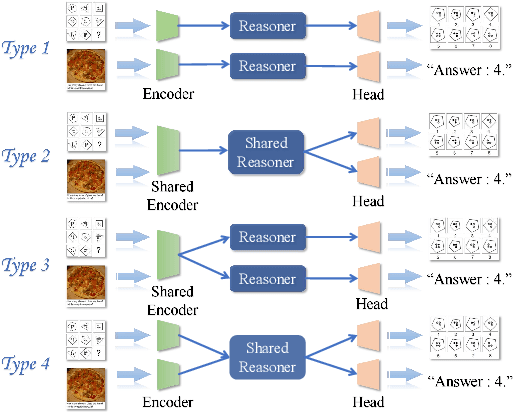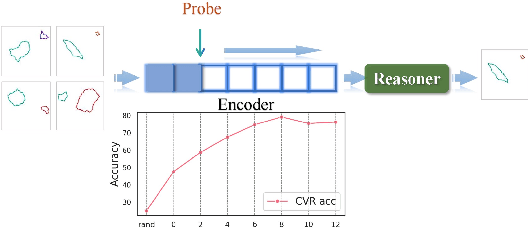Yue Xu
Robert
exUMI: Extensible Robot Teaching System with Action-aware Task-agnostic Tactile Representation
Sep 18, 2025Abstract:Tactile-aware robot learning faces critical challenges in data collection and representation due to data scarcity and sparsity, and the absence of force feedback in existing systems. To address these limitations, we introduce a tactile robot learning system with both hardware and algorithm innovations. We present exUMI, an extensible data collection device that enhances the vanilla UMI with robust proprioception (via AR MoCap and rotary encoder), modular visuo-tactile sensing, and automated calibration, achieving 100% data usability. Building on an efficient collection of over 1 M tactile frames, we propose Tactile Prediction Pretraining (TPP), a representation learning framework through action-aware temporal tactile prediction, capturing contact dynamics and mitigating tactile sparsity. Real-world experiments show that TPP outperforms traditional tactile imitation learning. Our work bridges the gap between human tactile intuition and robot learning through co-designed hardware and algorithms, offering open-source resources to advance contact-rich manipulation research. Project page: https://silicx.github.io/exUMI.
Display Content, Display Methods and Evaluation Methods of the HCI in Explainable Recommender Systems: A Survey
May 14, 2025Abstract:Explainable Recommender Systems (XRS) aim to provide users with understandable reasons for the recommendations generated by these systems, representing a crucial research direction in artificial intelligence (AI). Recent research has increasingly focused on the algorithms, display, and evaluation methodologies of XRS. While current research and reviews primarily emphasize the algorithmic aspects, with fewer studies addressing the Human-Computer Interaction (HCI) layer of XRS. Additionally, existing reviews lack a unified taxonomy for XRS and there is insufficient attention given to the emerging area of short video recommendations. In this study, we synthesize existing literature and surveys on XRS, presenting a unified framework for its research and development. The main contributions are as follows: 1) We adopt a lifecycle perspective to systematically summarize the technologies and methods used in XRS, addressing challenges posed by the diversity and complexity of algorithmic models and explanation techniques. 2) For the first time, we highlight the application of multimedia, particularly video-based explanations, along with its potential, technical pathways, and challenges in XRS. 3) We provide a structured overview of evaluation methods from both qualitative and quantitative dimensions. These findings provide valuable insights for the systematic design, progress, and testing of XRS.
Building Machine Learning Challenges for Anomaly Detection in Science
Mar 03, 2025



Abstract:Scientific discoveries are often made by finding a pattern or object that was not predicted by the known rules of science. Oftentimes, these anomalous events or objects that do not conform to the norms are an indication that the rules of science governing the data are incomplete, and something new needs to be present to explain these unexpected outliers. The challenge of finding anomalies can be confounding since it requires codifying a complete knowledge of the known scientific behaviors and then projecting these known behaviors on the data to look for deviations. When utilizing machine learning, this presents a particular challenge since we require that the model not only understands scientific data perfectly but also recognizes when the data is inconsistent and out of the scope of its trained behavior. In this paper, we present three datasets aimed at developing machine learning-based anomaly detection for disparate scientific domains covering astrophysics, genomics, and polar science. We present the different datasets along with a scheme to make machine learning challenges around the three datasets findable, accessible, interoperable, and reusable (FAIR). Furthermore, we present an approach that generalizes to future machine learning challenges, enabling the possibility of large, more compute-intensive challenges that can ultimately lead to scientific discovery.
DR.GAP: Mitigating Bias in Large Language Models using Gender-Aware Prompting with Demonstration and Reasoning
Feb 17, 2025Abstract:Large Language Models (LLMs) exhibit strong natural language processing capabilities but also inherit and amplify societal biases, including gender bias, raising fairness concerns. Existing debiasing methods face significant limitations: parameter tuning requires access to model weights, prompt-based approaches often degrade model utility, and optimization-based techniques lack generalizability. To address these challenges, we propose DR.GAP (Demonstration and Reasoning for Gender-Aware Prompting), an automated and model-agnostic approach that mitigates gender bias while preserving model performance. DR.GAP selects bias-revealing examples and generates structured reasoning to guide models toward more impartial responses. Extensive experiments on coreference resolution and QA tasks across multiple LLMs (GPT-3.5, Llama3, and Llama2-Alpaca) demonstrate its effectiveness, generalization ability, and robustness. DR.GAP can generalize to vision-language models (VLMs), achieving significant bias reduction.
Auto-Search and Refinement: An Automated Framework for Gender Bias Mitigation in Large Language Models
Feb 17, 2025Abstract:Pre-training large language models (LLMs) on vast text corpora enhances natural language processing capabilities but risks encoding social biases, particularly gender bias. While parameter-modification methods like fine-tuning mitigate bias, they are resource-intensive, unsuitable for closed-source models, and lack adaptability to evolving societal norms. Instruction-based approaches offer flexibility but often compromise task performance. To address these limitations, we propose $\textit{FaIRMaker}$, an automated and model-independent framework that employs an $\textbf{auto-search and refinement}$ paradigm to adaptively generate Fairwords, which act as instructions integrated into input queries to reduce gender bias and enhance response quality. Extensive experiments demonstrate that $\textit{FaIRMaker}$ automatically searches for and dynamically refines Fairwords, effectively mitigating gender bias while preserving task integrity and ensuring compatibility with both API-based and open-source LLMs.
Graph Neural Patching for Cold-Start Recommendations
Oct 18, 2024



Abstract:The cold start problem in recommender systems remains a critical challenge. Current solutions often train hybrid models on auxiliary data for both cold and warm users/items, potentially degrading the experience for the latter. This drawback limits their viability in practical scenarios where the satisfaction of existing warm users/items is paramount. Although graph neural networks (GNNs) excel at warm recommendations by effective collaborative signal modeling, they haven't been effectively leveraged for the cold-start issue within a user-item graph, which is largely due to the lack of initial connections for cold user/item entities. Addressing this requires a GNN adept at cold-start recommendations without sacrificing performance for existing ones. To this end, we introduce Graph Neural Patching for Cold-Start Recommendations (GNP), a customized GNN framework with dual functionalities: GWarmer for modeling collaborative signal on existing warm users/items and Patching Networks for simulating and enhancing GWarmer's performance on cold-start recommendations. Extensive experiments on three benchmark datasets confirm GNP's superiority in recommending both warm and cold users/items.
Defending Jailbreak Attack in VLMs via Cross-modality Information Detector
Aug 01, 2024Abstract:Vision Language Models (VLMs) extend the capacity of LLMs to comprehensively understand vision information, achieving remarkable performance in many vision-centric tasks. Despite that, recent studies have shown that these models are susceptible to jailbreak attacks, which refer to an exploitative technique where malicious users can break the safety alignment of the target model and generate misleading and harmful answers. This potential threat is caused by both the inherent vulnerabilities of LLM and the larger attack scope introduced by vision input. To enhance the security of VLMs against jailbreak attacks, researchers have developed various defense techniques. However, these methods either require modifications to the model's internal structure or demand significant computational resources during the inference phase. Multimodal information is a double-edged sword. While it increases the risk of attacks, it also provides additional data that can enhance safeguards. Inspired by this, we propose $\underline{\textbf{C}}$ross-modality $\underline{\textbf{I}}$nformation $\underline{\textbf{DE}}$tecto$\underline{\textbf{R}}$ ($\textit{CIDER})$, a plug-and-play jailbreaking detector designed to identify maliciously perturbed image inputs, utilizing the cross-modal similarity between harmful queries and adversarial images. This simple yet effective cross-modality information detector, $\textit{CIDER}$, is independent of the target VLMs and requires less computation cost. Extensive experimental results demonstrate the effectiveness and efficiency of $\textit{CIDER}$, as well as its transferability to both white-box and black-box VLMs.
Take A Step Back: Rethinking the Two Stages in Visual Reasoning
Jul 29, 2024



Abstract:Visual reasoning, as a prominent research area, plays a crucial role in AI by facilitating concept formation and interaction with the world. However, current works are usually carried out separately on small datasets thus lacking generalization ability. Through rigorous evaluation of diverse benchmarks, we demonstrate the shortcomings of existing ad-hoc methods in achieving cross-domain reasoning and their tendency to data bias fitting. In this paper, we revisit visual reasoning with a two-stage perspective: (1) symbolization and (2) logical reasoning given symbols or their representations. We find that the reasoning stage is better at generalization than symbolization. Thus, it is more efficient to implement symbolization via separated encoders for different data domains while using a shared reasoner. Given our findings, we establish design principles for visual reasoning frameworks following the separated symbolization and shared reasoning. The proposed two-stage framework achieves impressive generalization ability on various visual reasoning tasks, including puzzles, physical prediction, and visual question answering (VQA), encompassing both 2D and 3D modalities. We believe our insights will pave the way for generalizable visual reasoning.
FAFE: Immune Complex Modeling with Geodesic Distance Loss on Noisy Group Frames
Jul 01, 2024



Abstract:Despite the striking success of general protein folding models such as AlphaFold2(AF2, Jumper et al. (2021)), the accurate computational modeling of antibody-antigen complexes remains a challenging task. In this paper, we first analyze AF2's primary loss function, known as the Frame Aligned Point Error (FAPE), and raise a previously overlooked issue that FAPE tends to face gradient vanishing problem on high-rotational-error targets. To address this fundamental limitation, we propose a novel geodesic loss called Frame Aligned Frame Error (FAFE, denoted as F2E to distinguish from FAPE), which enables the model to better optimize both the rotational and translational errors between two frames. We then prove that F2E can be reformulated as a group-aware geodesic loss, which translates the optimization of the residue-to-residue error to optimizing group-to-group geodesic frame distance. By fine-tuning AF2 with our proposed new loss function, we attain a correct rate of 52.3\% (DockQ $>$ 0.23) on an evaluation set and 43.8\% correct rate on a subset with low homology, with substantial improvement over AF2 by 182\% and 100\% respectively.
Unsupervised Monocular Depth Estimation Based on Hierarchical Feature-Guided Diffusion
Jun 14, 2024



Abstract:Unsupervised monocular depth estimation has received widespread attention because of its capability to train without ground truth. In real-world scenarios, the images may be blurry or noisy due to the influence of weather conditions and inherent limitations of the camera. Therefore, it is particularly important to develop a robust depth estimation model. Benefiting from the training strategies of generative networks, generative-based methods often exhibit enhanced robustness. In light of this, we employ a well-converging diffusion model among generative networks for unsupervised monocular depth estimation. Additionally, we propose a hierarchical feature-guided denoising module. This model significantly enriches the model's capacity for learning and interpreting depth distribution by fully leveraging image features to guide the denoising process. Furthermore, we explore the implicit depth within reprojection and design an implicit depth consistency loss. This loss function serves to enhance the performance of the model and ensure the scale consistency of depth within a video sequence. We conduct experiments on the KITTI, Make3D, and our self-collected SIMIT datasets. The results indicate that our approach stands out among generative-based models, while also showcasing remarkable robustness.
 Add to Chrome
Add to Chrome Add to Firefox
Add to Firefox Add to Edge
Add to Edge